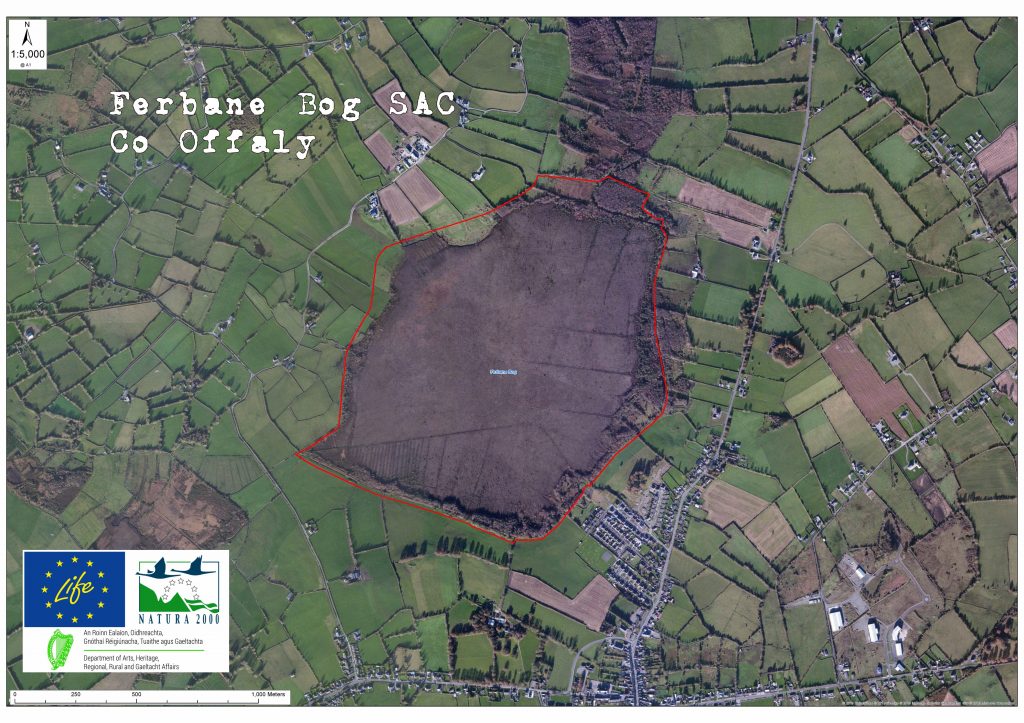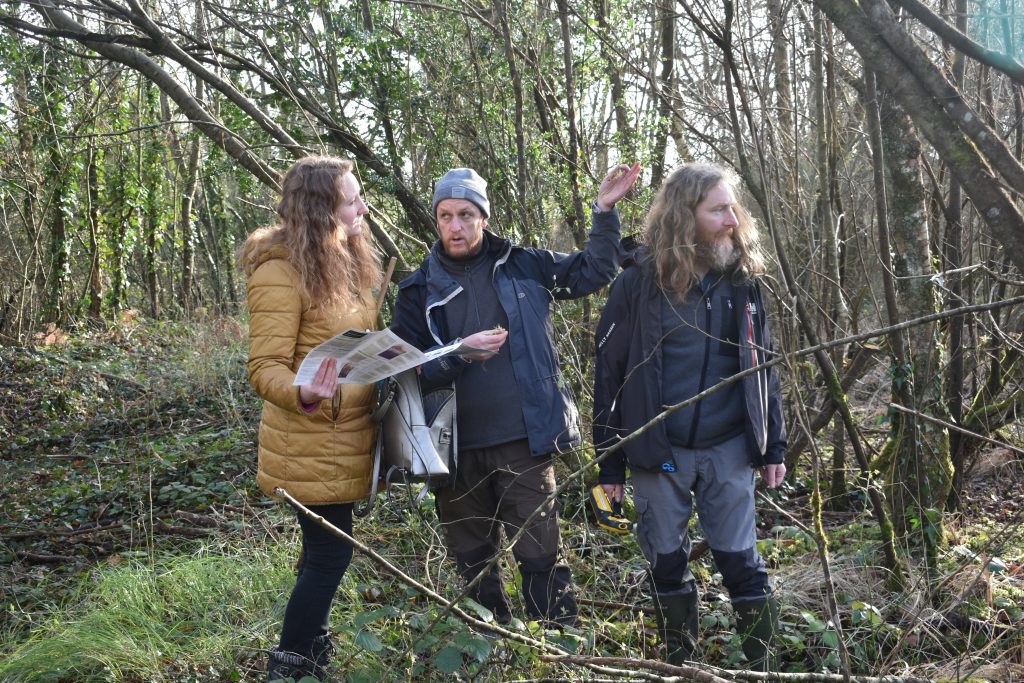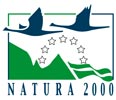The current conservation objective for Ferbane Bog is to restore the area of Active Raised Bog to the area present when the Habitats Directive came into force in 1994. In the case of Active Raised Bog, the objective also includes the restoration of Degraded Raised Bog.
The Area objective for Active Raised Bog (all on the high bog) is 43.51ha – almost double the existing area of active raised bog.
Restoration works included the blocking of drains, the construction of over a thousand peat dams and the installation of a number of plastic dams. A drainage management plan and a fire management plan were also drawn up.
Restoration works began here in August 2019 and continued for just over 4 months. In all, some 1,129 peat dams were installed with a number of plastic dams also put in.
Planning permission for visitor facilitation at Ferbane was granted by offaly County Council in 2020. It is planned to commence work on visitor facilities to make this impressive bog more visitor friendly for locals and tourists alike in August 2021. Ferbane Tidy Towns and Gallen Community School in the town assisted greatly with the plans. As well as signs and notice boards, boardwalks, and a special Mary Ward discovery field for science and biodiversity projects, there will be improvements to existing paths and roads alongside parking and a community area.

Boardwalks, such as this one in Co Laois, are an option to increase the amenity value of certain Irish raised bogs
OUT ON THE BOG
The objective in relation to Structure and Functions (S&Fs) is that at least half of the Active Raised Bog area should be made up of the central ecotope and active flush (i.e. the wetter vegetation communities). These values have been set as Favourable Reference Values.
Degraded Raised Bog still capable of regeneration should be, according to the interpretation manual, capable of regeneration to ‘active raised bog’ in 30 years if appropriate measures are put in place (i.e. no major impacting activities are present and any necessary restoration works are implemented).
In the past the habitat area was considered to be all high bog not considered to be active, but this is now not accepted as much of the high bog can no longer be restored to active (see DAHG 2014). The remaining non-active high bog is considered supporting habitat for the Annex I habitats on the high bog. This supporting habitat is an essential part of the hydrological unit necessary to support Active and Degraded Raised Bog habitats. The restoration of suitable cutover areas is essential for Active Raised Bog to achieve the favourable conservation condition at the site.

Cutover restoration at Killyconny Bog, Co Cavan.
Nevertheless it is acknowledged that a long period of time (i.e. over 30 years) may be needed after appropriate restoration works are undertaken on the cutover areas for the habitat to develop.
Restoration works along the western cutover of another of our project sites, Killyconny Bog SAC, by a previous LIFE project indicated the occurrence of pioneer ‘active raised bog’ vegetation 8 years after these were undertaken. Based on the close ecological relationship between Active Raised Bog, Degraded Raised Bog and Rhynchosporion depressions, it is considered that should favourable conservation condition for ‘Active Raised Bog’ be achieved on the site, then, as a consequence, favourable conservation condition for the other two habitats would also be achieved.
With a surface area of 153.08 hectares, Ferbane Bog SAC is a relatively large, domed, raised bog situated north-west of Ferbane town. Of our 12 project sites it is the closest one to a town.
It is one of six Offaly bogs which are LIFE project sites, and is one of the finest examples of typical midlands raised bog of the basin type – wet and spongy and rich in flora (with Sphagnum cover reaching 100% in places). There are almost 100 species thriving on the high bog, and the bog as a whole supports a large number of birds, mammals and amphibians, with the threatened Curlew recently reported here. Other birds to have frequented Ferbane Bog include Snipe, Meadow Pipit, Skylark, Merlin, Kestral and Sparrowhawk.

Prior to our restoration works, uncut high bog dominates the site (119.96ha) and is surrounded by a narrow band of cutover (33.12ha) resulting from previous turf-cutting. Approximately 27% of the high bog surface consists of very wet active bog with the remainder degraded largely due to the hydrology being affected by peat cutting, drainage and other land use activities.
But, though 72% of the high bog may be classified as degraded, it is still capable of regeneration.
Ferbane Bog has suffered extensive drainage in the past, with the south and east traversed by drains. The drainage has caused significant drying out of the bog and past peat-cutting speeded up water loss, with exposed face banks and high bog drains multiplying the loss. An abundance of pines in three parts of the bog also indicated that this site is drying out.
However, although the high bog has suffered in terms of hydrology, it is still in a favourable, restorable condition and is rich in flora and fauna. Peat-cutting ceased on Ferbane in and around 2011.

Bog Cotton (Eriophorum angustifolium) -a plant of damp, peaty ground. Did you know Ferbane is named after it? Féar Bán, meaning white grass, is common in this part of the country.
In order to restore the hydrology of Ferbane bog, the LIFE project team blocked almost 16,000 metres of drains, among other restoration actions. Restoration works took place here between August 2019 and December 2019, and saw the installation of almost 1,200 peat dams and a number of plastic ones. The amount of works here were substantial compared to other project sites, with more dams installed only on Carrownagappul Bog in Galway.
Ferbane Bog is a fine example of a raised bog and is of considerable conservation significance. Active raised bogs are becoming increasingly rare in Ireland and Europe, and Ferbane is one of the best examples of what remains.
Ferbane bog is a candidate Special Area of Conservation (cSAC) selected for Active Raised Bogs 7110, Degraded Raised Bog 7120 and Depressions on peat substrates (Rhynchosporion) 7150 – habitats that are listed on Annex I of the EU Habitats Directive (992/43/EEC), where Active Raised Bogs 7110 is further ranked as a “priority” habitat.








